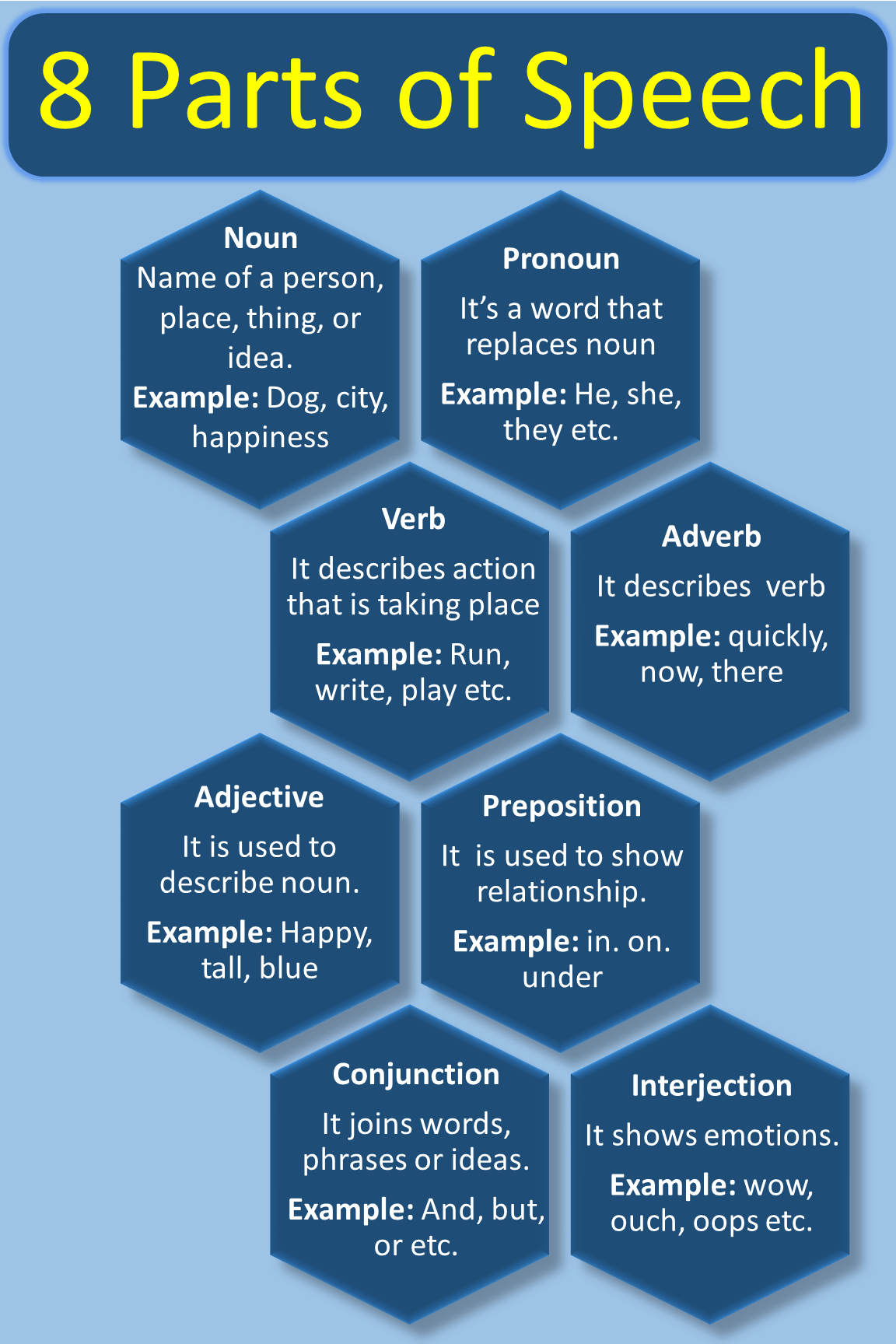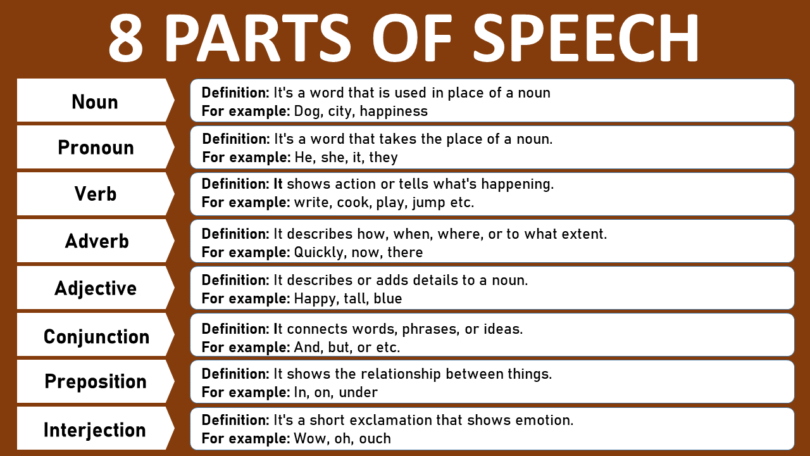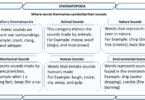Imagine you are solving a puzzle, Do you know the importance of putting it all in the right way? Words are exactly like puzzle pieces, each having its significance. These words are called “Parts of Speech.” Parts of Speech play an important role in English Grammar, being building blocks of the English language, to convey meaning and construct sentences.
Parts of Speech are the categories in which words are classified on the basis of basis of grammar. It defines the role of these words in sentence construction. Let’s explore Eight Parts of Speech, to enhance your understanding and knowledge. There are eight parts of speech.
Let your emotions flow through beautiful words—start exploring the best Hindi Shayari today. Share your feelings, celebrate life, and connect with others on a deeper level.
These are Eight Parts of Speech:
- Noun
- Pronoun
- Verbs
- Adverb
- Adjectives
- Preposition
- Conjunction
- Interjection
Nouns:
The word Noun is derived from Latin “Nomen” meaning “Name” Noun is defined as part of speech that refers to the name of a person, thing, or place. It could be the name of any specific object like living creatures, actions, places, qualities, ideas, or state of existence. A noun can act as a subject or an object in a sentence. Nouns have various properties and are classified depending on their occurrence.
Types of Noun in Eight Parts of Speech:
| Sr no | Type of Noun | Description | Examples |
| 1 | Common noun | Any general idea or object | Girl, Boy |
|---|---|---|---|
| 2 | Proper noun | Name of particular person, place, or thing | United States of America |
| 3 | Abstract noun | A noun that cannot be perceived through the five senses | Love |
| 4 | Collective noun | A specific group of people, places, or things | Colony, Herd |
| 5 | Compound noun | Two or more than two words combine and function as a noun. | Atlantic Ocean |
| 6 | Possessive Nouns | Shows ownership or possession | Aira’s bag or Sam’s car |
| 7 | Concrete Noun | A noun that can be perceived through the five senses | Piano |
| 8 | Countable Noun | A noun we can count as individual units. | Two apples, Three chocolates, |
| 9 | Uncountable Noun | A noun refers to a group or collection of people, animals, or things. | Flock, Team, Herd |
| 10 | Singular Noun | When you refer to one thing, person or place. | Pen, chair, Book |
| 10 | Plural noun | A group of people, things or places. | Pens, Hostels, Books |
| 11 | Concrete Noun | A noun that can be perceived through the five senses | Piano |
Examples of nouns used in sentences:
- I saw a cute kid in park.
- He always carries his inhaler with him.
Pronouns:
They function as a noun. A pronoun is defined as a word which replaces a noun in a sentence. Using pronouns in sentences is a way to avoid repetition of the same words. Pronouns are words like he, she, we, you, they etc. For example, Consider “Lisa went to market. She bought a new dress.” instead of “Lisa went to market. Lisa bought a new dress.” Isn’t the first one more attractive and structured?
Types of Pronoun in Eight Parts of Speech:
| Sr no | Type of Pronoun | Definition | Example |
| 1 | Personal Pronouns | Personal pronoun is used to replace specific things, groups, or persons. | She is going to the market. |
| 2 | Demonstrative Pronouns | Demonstrative pronouns used to direct to specific items or groups. | I preferred this dress over that one. |
| 3 | Relative Pronoun | Relative pronouns are used to connect phrases. | The person who went, came back. |
| 4 | Indefinite Pronoun | Indefinite pronouns are used to refer to nonspecific things or persons. | Everyone should bring their own lunch. |
| 5 | Interrogative Pronoun | Interrogative pronouns are used to ask questions. | What are you cooking for dinner? |
| 6 | Possessive Pronoun | Possessive pronouns used to show possession. | Is this dress his or yours? |
| 7 | Reflexive Pronoun | Used when the subject and object refer to the same entity. | She cut herself while cooking. |
| 8 | Subject Pronoun | Used as the subject of a sentence. | He is going to the store |
| 9 | Object Pronoun | Used as the object of a verb or preposition. | She gave the rose to me. |
| 10 | Reciprocal Pronoun | Indicates an action carrying out reciprocally. | They hugged themselves after the test. |
Examples of pronouns used in sentences:
He is going to the store to buy groceries.
She finished her project ahead of schedule.
They are planning a surprise party for him.
Verbs:
Verb is defined as a word that describes any action, state, or occurrence. Verbs express states, actions or occurrences. A verb tells us action done by the subject of a sentence. Presence of one verb in a sentence is a compulsion and verbs are a vital and central component of a sentence. A sentence can be composed only on a single verb at the most basic level. For example, the words write, describe, eat and play are verbs. Did you realise that verbs are used in different types that don’t necessarily behave similarly. Correct use of verbs is important.
Types of Verb in Eight Parts of Speech:
| Sr no. | Verb Type | Description | Example |
|---|---|---|---|
| 1 | Action Verbs | Express physical or mental actions. | She cook perfectly. |
| 2 | Linking Verbs | Connect the subject to a subject complement, indicating a state of being. | Aira is a talented writer. |
| 3 | Helping Verbs | Assist the main verb in a sentence, indicating tense, possibility, necessity, etc. | She is preparing for the practical. |
| 4 | Modal Verbs | Express ability, possibility, necessity, permission, or probability. | She must complete the homework. |
| 5 | Transitive Verbs | Require a direct object to complete their meaning. | We ate the delicious Pasta. |
| 6 | Intransitive Verbs | Do not require a direct object. | The kid slept on the sofa. |
| 7 | Reflexive Verbs | Reflect the action back onto the subject. | She hurt herself while playing. They enjoyed themselves at the party. |
| 8 | Phrasal Verbs | Consist of a main verb and one or more particles (prepositions or adverbs). | I looked up the topic in the notes. |
| 9 | Irregular Verbs | Have unpredictable conjugations in past and past participle forms. | We ate breakfast early today. |
| 10 | Regular Verbs | Follows a regular conjugation pattern. | He always writes to Peter. |
| 11 | Dynamic Verb | Describes actions or processes. | The river flows smoothly. |
| 12 | Stative Verb | Shows a state or condition. | She knows her secret. |
| 13 | The Gerunds and Infinitives | A verb form that functions as a noun is called gerund | She is learning physiology. |
Use of verbs in Eight Parts of Speech:
- Sarah published an article and a book.
- Sara is baking cakes and pizza.
- She did it perfectly.
- The dress looks beautiful.
- I have finished my work.
Adverbs:
These provide additional information about verbs, adjectives, or other adverbs, answering questions like “how,” “when,” or “where”.They describe or modify verbs, adjectives, or other adverbs and provide information about actions like when, how, where it is done. Adverbs add meaning to sentences, giving the overall meaning of the action or its quality.
Types of Adverb:
| Sr no | Type of adverb | Description | Example |
| 1 | Adverbs of Manner | It describe how a work is done | Quickly, elegantly, fastly, slowly, carefully and cleverly etc. |
| 2 | Adverbs of Time | These adverbs describe when timings of action take place. | Soon, now, tomorrow, and later etc |
| 3 | Adverbs of Place | These adverbs describe the place of action. | Here, there, everywhere, and nowhere etc |
| 4 | Adverbs of Frequency | Adverbs that express how many times anything is done. | Often, rarely, always and never etc |
| 5 | Adverb of Degree | It modifies other adverbs or adjectives, indicating the intensity of the action. | Include very, almost, too, and quite etc |
| 6 | Adverbs of Certainty | They exhibit the level of certainty of an action | Definitely, certainly, absolutely |
Use of adverbs in Eight Parts of Speech
- She did it perfectly.
- He rarely misses his morning walk.
- He runs fastly.
Adjectives:
Adjective is defined as a word that adds detail and description to a noun or pronoun. Adjectives modify or describe nouns or pronouns. Examples include “interesting”, “beautiful,” “tall,” and “mysterious.” Adjectives enhance the writing because it qualifies nouns and pronouns. You can use adjectives to qualify objects independently or in comparison with something else.
Types of Adjectives, and its role in Eight Parts of Speech:
| Sr no | Type of adjective | Description | Example |
| 1 | Quantitative adjective | Indicates quantity of noun. | Some, few, many etc |
| 2 | Numeral adjective | Used to represent nouns with reference to a number. | First, second etc |
| 3 | Descriptive adjective | Define characteristics and the qualities of a noun | Happy, beautiful, sad |
| 4 | Demonstrative adjective | It is used to point out the noun that is described. | That, those, this etc |
| 5 | Exclamatory adjective | Used to show possession or ownership. | Examples are my, his,your, her, our etc |
| 6 | Interrogative adjective | It is used to ask about a noun. | What, how, which etc |
| 7 | Possessive adjective | Shows possession | My, his, her etc |
| 8 | Comparative adjective | Used to compare nouns, indicate a higher and lower degree. | bigger, smaller, more intelligent |
| 9 | Superlative adjective | Used to indicate the highest or lowest degree of a quality. | Examples are smallest, biggest, most intelligent |
Use of Adjectives in Eight Parts of Speech:
- I prefer this dress over the one she recommended.
- Only a few students attended the lecture.
- She was the first girl to guide me.
- This is the most beautiful dress I have ever seen.
Prepositions:
Prepositions are words that establish relationships in a sentence. It may describe the relationship between noun, pronoun or other parts of a sentence. It describe location, time, manner or direction of the work that is being done. Examples include between, below and above etc.
Types of prepositions:
| Sr. no | Type | Description | Example |
| 1 | Simple Prepositions: | It shows relationships. | She is sitting on the chair. |
| 2 | Compound Prepositions | Combination of two or more words. | He walked alongside the river. |
| 3 | Double Preposition | Forms by combining two simple prepositions | According to results, we won. |
| 4 | Phrasal Preposition | Two or more words functions as a single prepositional phrase | He sat down in front of the TV. |
| 5 | Participle Preposition | It forms from a participle. | During the meeting, she took notes. |
| 6 | Prepositions of Time: | Indicates time when an action takes place. | She will meet you at home tomorrow. |
| 7 | Prepositions of Place: | Specify location of something. | She is hiding behind the sofa. |
| 8 | Prepositions of Direction | Indicates the direction of movement. | He walked towards the restaurant |
| 9 | Prepositions of Manner | Shows the reason behind an action. | He was shivering with cold. |
| 10 | Prepositions of Agent | Indicates who performs an action. | A skilled artist created the painting. |
| 11 | Preposition of Possession | Shows ownership between two elements. | The colour of the shirt is red. |
| 12 | Monadic Preposition | Shows a single object, relate the subject to time, place, or manner. | He sat in the street. |
| 13 | Dyadic Preposition | Shows two objects and highlight their relationship. | The book is between two bookends. |
| 14 | Adverbial Preposition | It functions as adverbs and modify verbs. | He walked in fastly. |
| 15 | Adjectival Preposition | Function as adjective and modify nouns | The girl with glasses is my friend. |
| 16 | Prepositions of Manner | Describes how an action is performed. | She completed her homework with dedication. |
| 17 | Prepositions of Condition: | Shows circumstances under which an action occurs. | They will cancel their plan unless it stops hailing. |
| 18 | Prepositions of Purpose | Indicate the purpose for an action. | We went to the market for groceries. |
Use of prepositions in sentences:
- He placed the cup on the shelf.
- They went to KFC and market after school.
- The keys are on the table.
- They are jogging on the track.
Conjunctions:
A conjunction connect words, clauses or phrases in a sentence. It establish relationship between words, clauses and phrases. It joins elements, and provide a smooth flow to sentence structure. There are different types of conjunctions and these are classified according to their specific purpose. The main types of conjunctions include coordinating conjunctions, correlative conjunctions and subordinating conjunctions.
Types of conjunctions, and its role in in Eight Parts of Speech:
| Sr no. | Types | Description | Example |
| 1 | Coordinating | Connects words, phrases, or independent clauses of equal importance. | She likes coffee and tea. I want to go, but it’s raining. He can sing or dance. |
| 2 | Subordinating | Introduces a subordinate clause, indicating a relationship with the main clause. | I’ll go to the park if the weather is nice. She left the party because she felt tired. |
| 3 | Correlative | Comes in pairs and connects similar elements within a sentence. | You can either eat the cake or save it for later. Not only did she study, but also she practiced. |
Use of conjunction in sentences:
- I like both chocolate and vanilla ice cream.
- I will go to the beach if the weather is sunny.
- They continued playing outside although it started raining.
- She stayed at home because she wasn’t feeling well.
- The team is both talented and hardworking.
Interjections:
Interjections convey emotions. They fill life into expressions. They express feelings like joy, happiness, feelings, frustration, excitement etc. Examples include Oh, Wow, and Ouch.
Types of Interjections:
| Sr no | Type of Interjection | Description | Examples |
| 1 | Joyful Interjection | It express joy, happiness or excitement. | Woo-hoo! |
| 2 | Surprise Interjection | To convey surprised or unexpected reactions. | Oh! |
| 3 | Exclamatory Interjections | Express reactions or emotions | Ouch |
| 4 | Conversational Interjections | Helps in informal communication | Anyway! |
| 5 | Positive Interjections | Shows positive emotions | Fantastic! |
| 6 | Negative Interjections | Convey negative emotions | Ugh! |
| 7 | Casual Interjections | Helps in casual communication | Uh-huh! |
| 8 | Formal Interjections | It enables formal communication | Alas! |
| 9 | Mild Interjections | Express moderate emotions | Er! |
| 10 | Strong Interjections | Shows intense emotions | Whoa! |
| 11 | Expressive Interjections | Adding emotion to statements | Eureka! |
| 12 | Attention-Grabbing Interjections | Capturing someone’s focus | Hey! |
| 13 | Interruptive Interjections | It interrupts a conversation, | Stop! |
| 14 | Responsive Interjections | Helps responding to something | Oh, I see. |
Examples of Interjections, and its use in Eight Parts of Speech:
- Wow, what a beautiful decor!
- Wow! That’s an outstanding trick!
- Welldone! You delivered a fantastic speech.
- Opps, that hurts!
- Bye! Have a safe journey!

Learn Eight Parts of Speech – English Grammar
In conclusion, a proper knowledge of parts of speech is necessary for grammatically correct and coherent sentence structure. Mastering parts of speech enhances your language skills because it craft a compelling narrative and express your thoughts. Learning parts of speech allows you to convey your ideas with clarity because it gives understanding of how to use nouns, pronouns, and other parts of speech.







